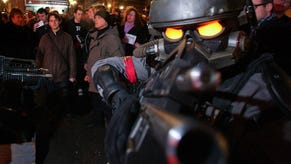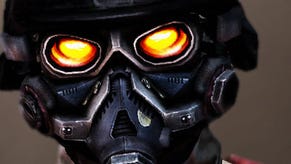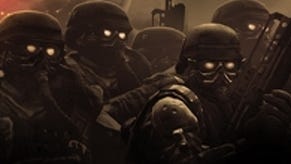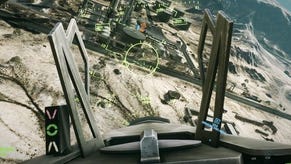Killzone 3
Ol' red-eyes is back.
From the ground the pack will propel you upwards to around 15 feet, with the glide period afterwards giving you the freedom to traverse sizeable gaps. There's a booster, too - squirting you forward in short bursts if you're falling just short of an edge. Controls are light and agile, with the disconcerting verticality soon becoming second nature.
It gives us an excellent chance to appreciate the scale of the new level, which has a footprint around ten times larger than the average Killzone 2 equivalent. It's not all there to explore, this particular example is largely comprised of open sea and fractured ice, but the expanses offer a welcome respite from the rat-tunnel claustrophobia of Pyrrhus.
Killzone isn't moving into open world territory, however. As Hulst is keen to point out, "To make sure it's spectacular we've also loaded it up with lots of epic cinematic moments and explosive set-pieces. So aside from the sheer scale, the first three minutes of this level contain more set pieces than the entire first level of KZ2."
It's a sentiment borne out in our first dogfight. Coming across three Helghan Jetpack troopers, a nearby ice-arch provides valuable cover, offering protection from the withering fire of the three guns above. Soon, however, the improved AI kicks in and the troopers bracket me. Hopping in and out of view on either side of the arch, they have me spinning wildly in the centre of a circle of gunfire - the cover which had been my saviour rapidly becoming a trap.
Fade to red, and time for another go.
This time I embrace my new-found aerial abilities, jetting upwards to take on the Helghan on their own terms. By doing this I'm able to keep a trooper in my sights at all times, using the boost to dart out of their firing lines. The controls prove to be simple to master, and two of the shock troops spiral into the frosty abyss below. Number three puts up a bit more resistance but before long he joins his companions in an icy grave, leaving me free to jet-jump my way up the crumbling iron facade of the rig.
It's nearing the end of our session, but one trick remains hidden up the collective sleeves of our hosts. It's only available at one demo pod, front and centre of the room, where we're seated in front of a very expensive looking, prototype 3D TV.
It's perhaps not a huge surprise. PS3D has been common knowledge for some time now, and it makes perfect sense that one of the platform's flagship series be earmarked for the technology's release. What is a surprise is how well it all actually works.

I manage to plumb the centre seat, which apparently gives the best impressions of the 3D magic at work, but the appreciative noises emanating from the journos either side of me are reassuring. We play through the same section again, although the pad remains firmly in the hands of the studio representative.
Straight away there's an immediate impact. The weighty, long-barrelled minigun has a real presence in-screen, highlighting the fact that the majority of Killzone's 3D trickery is done via the impression of depth rather than projection. Shuffling behind cover emphasises the effect superbly, each vanishing line and focal reference point making the illusion ever more real.
The game's particle effects really come into their own under the influence of the active shutter glasses too. Snow seems to swirl very distinctly in front of the screen, its fluttering hypnotism starkly punctuated by the bullets which zip and zing towards you. We're told there's a lot of work to be done on the perfection of the 3D yet, and in certain effects that's obvious, but generally the whole effect is a mesmerising one, drawing you into the screen and surrounding you with it, generally just in time to recoil from a projectile or ten. It also adds a competitive advantage, allowing players to judge the jetpack jumps with much greater accuracy. How that will skew the playing field between 3D enabled multiplayer users and their dimension-poorer counterparts remains to be seen.
In one of the more static moments, our demonstrator places a D-charge on the AA battery, the focus and lack of movement allowing a more advanced 3D technique to be used. It's startling how much depth is added to the scene. This is a fairly strenuous technique in terms of brain capacity, though, and we're informed that it's something which won't be happening too often. "If we were to do this during a combat scenario, your eyes would tire, your brain would malfunction. This is a game we want people to be able to play for hours at a time."
Judging by what's been shown so far, I can't see that being a problem.
Killzone 3 is due for release exclusively on PlayStation 3 in 2011.








